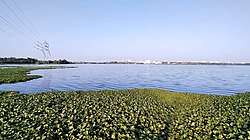Yele Mallappa Shetty Lake
Yele Mallappa Shetty Lake (Kannada: ಎಲೆ ಮಲ್ಲಪ್ಪ ಶೆಟ್ಟಿ ಕೆರೆ) also called Yele Mallappa Chetty Lake, is one of the largest lakes in Bangalore, located on the eastern side of the city, outside of KR Puram. It is an artificial water reservoir constructed in early 1900s.[1] The lake is spread over 105.218 ha (260.0 acres) of land, it was considered to be a beautiful ecosystem.[2]
| Yele Mallappa Shetty Lake | |
|---|---|
 Yele Mallappa Shetty Lake in 2019 winter time | |
| Location | Bangalore, Karnataka, India |
| Coordinates | 13°01′24.6″N 77°43′45.2″E |
| Type | Stale water |
| Native name | ಎಲೆ ಮಲ್ಲಪ್ಪ ಶೆಟ್ಟಿ ಕೆರೆ (Kannada) |
| Primary inflows | Rainfall and city drainage |
| Catchment area | 2.87 km2 (1.1 sq mi) |
| Basin countries | India |
| Surface area | 105.218 ha (260.0 acres) |
| Shore length1 | 3 km (1.9 mi) |
| Surface elevation | 903.26 m (2,963.5 ft) |
| Frozen | Never |
| Settlements | Bangalore |
| 1 Shore length is not a well-defined measure. | |
Geography
Yele Mallappa Shetty lake is located in North-East Bangalore, near Whitefield. The 260 acre Yele Mallappa Shetty lake is one of the largest lakes in Bangalore. The lake has the Old Madras Road passing through it.[3]
History
Yele Mallappa Shetty Lake derives its name from a leading philanthropist of 1900s by the name of Rai Bahadur Yele Mallappa Shetty. In the late 19th century when the city was suffering from a great drought, Yele Mallappa Shetty, a betel leaf merchant, generously donated a large part of his wealth to the construction of a tank to harvest rainwater and provide respite to the people.[4][1]
Flora and fauna
The lake is a biological hotspot for migratory birds, some of the usually spotted birds are golden oriole, northern shoveler, green bee-eater, bulbul, pied kingfisher, egrets, and Eurasian coot.[5]
Water quality
In 2015, University of Mysore had conducted a study and published the report of Yele Mallappa Shetty Lake. As part of Physico-chemical characteristics of Yele Mallappa Shetty Lake, The observations were made three times in a year representing three different seasons. The samples were collected from three different places of the lake.[6]
Following are the observations from the report:
- Physico-chemical analysis: Lake water contains different types of floating, dissolved, suspended and microbiological as well as bacteriological impurities.
- Temperature: Neither too high nor too low.
- pH: Normal range.
- Electrical Conductivity (EC): Higher side; indicating higher levels of alkalinity.
- Dissolved oxygen (DO): Lower than the standard.
- Bio-chemical Oxygen Demand (BOD): Moderate.
- Chemical oxygen demand (COD): Exceeded the limit in most of the samples. It clearly indicates the presence of high levels of dissolved contaminants.
- Hardness: Very high.
- Alkalinity: Higher side.
- Sodium: Concentration of sodium was found to be lower.
- Potassium: The concentration of potassium was high.
- Phosphate: Comparatively high amount of phosphate was recorded due to the discharge of municipality sewage and dumping of domestic waste into the lakes.
- Nitrate: Relatively larger amount of nitrate was found.
Impact of urbanization
Due to rapid growth of Bangalore urban area, Yele Mallappa Shetty Lake has been getting encroached over the time. The multi-storey apartments in its watershed region, which are constantly feeding stormwater drains completely but are also letting untreated sewage directly into it. Even industries from surrounding areas started dumping their waste into the lake.[7][8]
Sewage treatment plant
On 23 December 2017, Bengaluru Development Minister K J George Inaugurated the Yele Mallappa Shetty treatment plant at Seegehalli, the Sewage Treatment Plant is built to help treat 15 million litres of sewage water per day (MLD) generated at KR Puram, Hoodi, Mahadevapura, Bhattarahalli, Devasandra, Sadaramangala and Medhalli.[9]
Currently, the Bangalore Water Supply and Sewerage Board supplies treated sewage to neighboring regions such as Chikkaballapur, Kolar and Anekal for irrigation purpose.[2]
References
- "Construction debris eats away at another Bengaluru lake". The Times of India. 2019, timesofindia.indiatimes.com News Desk.
- "BWSSB plans to supply treated lake water to residential units". The Times of India. Retrieved 4 July 2019.
- "Yele Mallappa Shetty Lake on Google map". Google. Retrieved 15 March 2020.
- thehindu.com News Desk. "The spirit of sharing". The Hindu. 2013, india.com.
- "Yellamallappa Chetty (Yele Mallappa Shetty) Kere". ebird.org. Retrieved 30 November 2019.
- "Ecological Assessment and Conservation Strategies of Yele Mallappa Shetty Lake in Bengaluru, India" (PDF). researchgate.net. Retrieved 1 January 2015.
- "Hyacinth, weeds flourish in Ele Mallappa Shetty lake". Deccan Herald. Retrieved 27 January 2015.
- "Contamination of ground water in the northern part of Yele Mallappa Shetty kere" (PDF). Retrieved 24 December 2010.
- "All sewage in Bengaluru will be treated by 2020: Bengaluru Development Minister K J George". The New Indian Express. Retrieved 24 December 2017.
| Wikimedia Commons has media related to Yele Mallappa Shetty Lake. |